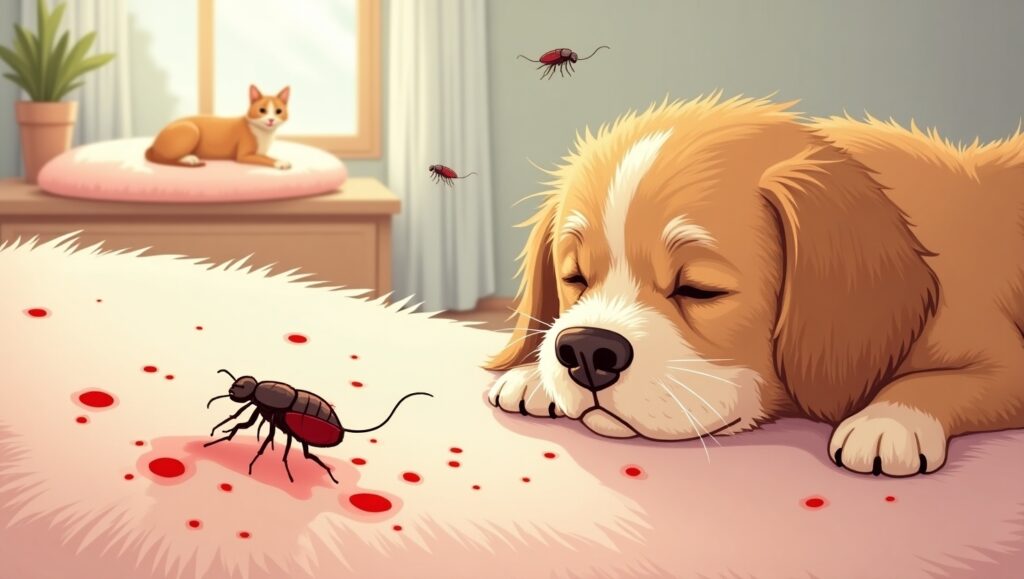Fleas may be tiny, but they can cause big problems. From itchy bites to severe infestations that affect your home, pets, and even your health, these pests are more than just a nuisance. If you’re living in Fort Wayne, Indiana, and dealing with a flea problem, understanding how they operate, bite, and spread is the first step toward effective flea control.
In this post, we’ll cover everything you need about flea bites, including symptoms, risks, prevention, treatment, and when to call a professional for help.
What Are Fleas?
Fleas are small, wingless insects that survive by feeding on the blood of mammals and birds. The most common flea in North America is the cat flea (Ctenocephalides felis), which infests cats, dogs, and even humans. Fleas are excellent jumpers, capable of leaping up to 7 inches vertically and 13 inches horizontally—allowing them to easily hop from host to host.
The Life Cycle of a Flea
Understanding the flea life cycle is key to stopping infestations before they explode. Fleas go through four main stages: egg, larva, pupa, and adult.
-
Eggs: Fleas lay eggs on their host, but the eggs often fall off onto carpets, bedding, or floorboards.
-
Larvae: The eggs hatch into larvae that feed on organic matter, including flea feces.
-
Pupae: Larvae spin cocoons and remain dormant until conditions are right for emergence.
-
Adults: Adult fleas emerge when they sense warmth, vibrations, or carbon dioxide—signs that a host is nearby.
Flea eggs can hatch in as little as 2 days, and the entire cycle can be completed in 2–3 weeks under ideal conditions. This rapid reproduction means that just a few fleas can quickly become a full-blown infestation.
How Do Fleas Bite Humans and Pets?
Fleas bite to consume blood, their only food source. A flea will use its specialized mouthparts to pierce the skin and suck blood. Most bites are painless initially but develop into itchy, red bumps that can cause extreme discomfort.
-
On Pets: Flea bites often cause constant scratching, biting, and licking. If untreated, pets can develop flea allergy dermatitis, a severe skin reaction.
-
On Humans, Flea bites usually appear on the legs, ankles, and feet. The bites are small, red, and often grouped in clusters of three or more.
Flea Bite Symptoms to Watch For
Understanding the symptoms of flea bites helps in identifying infestations early. Look out for:
-
Red, itchy bumps with a central puncture point
-
Clusters or lines of bites, usually on the lower legs
-
Allergic reactions like swelling, rashes, or excessive itching
-
Secondary infections from scratching
If your pet is scratching more than usual or if you notice tiny black specks (flea dirt) in their fur or bedding, fleas could be the culprit.
Are Flea Bites Dangerous?
Yes—especially if left untreated.
Fleas are not just annoying; they are also vectors for disease. They can transmit bacteria and parasites, including:
-
Murine Typhus: Caused by infected flea feces entering bite wounds.
-
Tapeworms: Pets and even children can get tapeworms by accidentally ingesting fleas.
-
Cat Scratch Disease (Bartonella henselae): Spread through flea feces on cats’ claws and skin.
In rare cases, flea infestations have caused anemia, particularly in kittens and small animals with heavy flea burdens.
Where Do Fleas Live and Breed?
Fleas thrive in warm, humid environments—which is why summer is peak flea season in Fort Wayne. Common places fleas live and breed include:
-
Pet bedding
-
Carpets and rugs
-
Cracks in hardwood floors
-
Under furniture
-
In outdoor areas like shaded lawns or doghouses
A single flea can lay up to 50 eggs a day, meaning infestations escalate rapidly without intervention.
How to Inspect Your Home for Fleas
Before you can treat fleas, you need to confirm they’re present. Here’s how to inspect your home:
1. Check Your Pets
Use a flea comb, especially around the neck, tail, and underbelly. Look for small, fast-moving insects or black flea dirt.
2. Examine Carpets and Upholstery
Put on white socks and walk slowly across carpets. Fleas often jump onto socks where they are visible. Check seams of furniture and baseboards.
3. Use a Flea Trap
You can purchase or make a flea trap using a light source and a bowl of soapy water. Fleas are attracted to warmth and light and will jump into the water.
4. Inspect Pet Bedding
This is often the epicenter of an infestation. Fleas, eggs, and larvae often accumulate where your pets sleep.
Regular inspections can help you catch flea problems before they become widespread.
How to Prevent Flea Bites in Your Home
Prevention is the best defense against flea infestations. Here are steps to keep fleas out of your home:
1. Treat Your Pets Regularly
Use vet-approved flea prevention treatments such as oral medications, topical drops, or flea collars. Groom pets regularly with a flea comb and check their fur for signs of fleas or flea dirt.
2. Clean Your Home Thoroughly
Vacuum your carpets, rugs, and upholstery frequently. Focus on pet resting areas and baseboards. Wash pet bedding and soft furnishings in hot water weekly.
3. Outdoor Flea Control
Keep your lawn trimmed and avoid letting pets roam into shaded, overgrown, or wooded areas where fleas are common. Outdoor flea treatments can reduce populations near your home.
Natural and Chemical Treatment Options for Fleas
If you’re already dealing with fleas, fast and targeted treatment is crucial. Here’s what you can do:
1. At-Home Remedies
-
Diatomaceous earth: A non-toxic powder that kills fleas by dehydrating them.
-
Lemon spray: Acts as a mild repellent, though not as effective for large infestations.
-
Baking soda + salt: Sprinkled on carpets to dehydrate flea eggs and larvae.
2. Over-the-Counter Products
-
Flea sprays for carpets and furniture
-
Flea shampoos and dips for pets
-
Flea foggers (insecticide bombs)
3. Professional Flea Control Services
When the infestation is widespread or recurring, it’s best to call a licensed Fort Wayne flea exterminator. Professional services use a combination of residual insecticides and growth regulators to eliminate fleas at all life stages.
When to Call a Professional Pest Control Service
You should call a pest control expert if:
-
You’ve tried DIY methods, and the fleas keep coming back.
-
Your pet or family members are suffering from severe bites.
-
You notice fleas in multiple areas of your home or yard.
-
You want to prevent fleas from spreading to other areas.
FAQs About Flea Bites and Flea Control
What do flea bites look like?
Flea bites are small red bumps with a central puncture mark. They often appear in groups or clusters, especially around the ankles, feet, and legs.
Can fleas live on humans?
Fleas prefer pets, but they can bite humans and live temporarily on clothing or bedding. They usually don’t stay on human skin for long.
How can I tell if my home has fleas?
Signs include excessive pet scratching, flea dirt (black specks), flea sightings, and bites on your legs or ankles. A flea comb can help detect fleas on pets.
How long does it take to get rid of fleas?
With proper treatment, mild infestations can be controlled in a few days. Severe infestations may take several weeks of ongoing treatment and monitoring.
Are flea bites dangerous for children?
Yes. Children may experience allergic reactions, infections from scratching, and in rare cases, parasitic infections like tapeworms.
Do fleas only affect pets with fur?
While fleas prefer furry hosts, they can also affect birds and hairless pets. They may still bite humans if pets are not around.
Will fleas die off in winter?
Fleas can survive indoors year-round. While outdoor flea activity may slow down in cold weather, indoor infestations can persist without treatment.
Can I get rid of fleas without chemicals?
Natural methods like diatomaceous earth and frequent vacuuming can help control mild flea problems, but heavy infestations usually require professional chemical treatment.
Final Thoughts
Fleas are more than an itchy inconvenience—they’re fast-multiplying pests that can harm your pets and your household. Whether you’re seeing the first signs of a problem or dealing with a full-blown infestation, timely and effective action is key. If you’re in Fort Wayne, don’t wait—reach out for professional flea control today.







